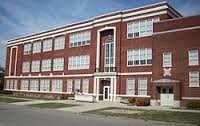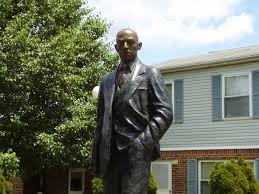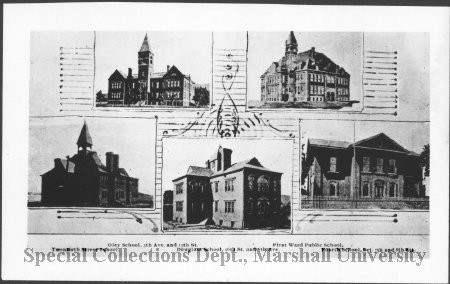Douglass Junior and Senior High School
Introduction
Text-to-speech Audio
Douglass Junior and Senior High School were the only schools for African Americans in Cabell County from their founding to 1954, when the state superintendent declared that segregation was over. Douglass remained open until 1961, a reflection of Huntington's reluctance to integrate as well as the Black community's desire to maintain a community school that had become such an important institution. The school had a profound impact on the African-American community in Huntington over its seventy years. Graduates include Hal Greer, the first African-American athlete at Marshall University and 76ers basketball player, and Carter G. Woodson, a Harvard-trained scholar known as "the father of Black history."
Images
Douglass Junior and Senior High School photo.

Statue of Carter Woodson at the site of the original Douglass High School.

Original school image is located on bottom row, center. Courtesy of Marshall University's Special Collection.

Backstory and Context
Text-to-speech Audio
Douglass Junior and Senior High School wasn't the original name of the building; in fact, the location isn't even the original location. Douglass Junior and Senior High School started out as Douglass High School, which had its first senior class graduate in 1893, on 16th St. and 8th Ave.
It is at the first building that Carter Woodson would begin his life long battle to stress the importance of African-American history. Being an all Black school, Woodson and his brother were drawn to the school in hopes to get a good education. Unfortunately for the young Woodson, money would cause him to work as a miner and keep his studying to a few months of his first three years in the area. At the age of twenty, Woodson entered Douglass High School and gradated in two years. After spending three years teaching, Woodson would return to Douglass High School to serve as the school's principal for three years while working on his Bachelor of Literature. He would later go on to be the second African-American to earn a doctorate from Harvard, he would teach in numerous areas of the country and even in the Philippines, be a radical member in the NAACP, serve as the dean of West Virginia Collegiate Institute, later West Virginia State University, and write countless books on African-American history. All of which has led him to be called the father of Black history.
In 1924, the new Douglass Junior and Senior High School was built to meet the changing demand in education standards and the rising Black enrollment. It is in this new building that another major African-American figure attended high school, Hal Greer. Greer begin his long basketball career at Douglass and, with some help from proximity, would become the first African-American athlete to play at Marshall University on their basketball team. While playing at an extremely high level in college, Greer would be drafted by the Syracuse Nationals, who would later become the Philadelphia 76ers, and would play alongside Wilt Chamberlain to win a NBA title. As of today, Hal Greer is the only African-American athlete from West Virginia to be in a major sports hall of fame.
While it is easy to get excited and carried away with names like Carter Woodson and Hal Greer, it is important to note that Douglass High School was more than just those two people. The school served as a close-knit community for many African-Americans in the Huntington area. One could compare it to a church or community center. Being so close to the Jim Crow South, a place like this really helped the community thrive in a time where racial equality didn't exist. Then in 1954 the ruling of Brown vs the Board of Education came down and abolished segregated schooling. It would take until 1961 until Douglass Junior and Senior High School would close, and its students would then attend Huntington High School, Old Huntington High School now. The building would still be used for special education until 1981 and then would be turned into a community center, which still is open today.
It is at the first building that Carter Woodson would begin his life long battle to stress the importance of African-American history. Being an all Black school, Woodson and his brother were drawn to the school in hopes to get a good education. Unfortunately for the young Woodson, money would cause him to work as a miner and keep his studying to a few months of his first three years in the area. At the age of twenty, Woodson entered Douglass High School and gradated in two years. After spending three years teaching, Woodson would return to Douglass High School to serve as the school's principal for three years while working on his Bachelor of Literature. He would later go on to be the second African-American to earn a doctorate from Harvard, he would teach in numerous areas of the country and even in the Philippines, be a radical member in the NAACP, serve as the dean of West Virginia Collegiate Institute, later West Virginia State University, and write countless books on African-American history. All of which has led him to be called the father of Black history.
In 1924, the new Douglass Junior and Senior High School was built to meet the changing demand in education standards and the rising Black enrollment. It is in this new building that another major African-American figure attended high school, Hal Greer. Greer begin his long basketball career at Douglass and, with some help from proximity, would become the first African-American athlete to play at Marshall University on their basketball team. While playing at an extremely high level in college, Greer would be drafted by the Syracuse Nationals, who would later become the Philadelphia 76ers, and would play alongside Wilt Chamberlain to win a NBA title. As of today, Hal Greer is the only African-American athlete from West Virginia to be in a major sports hall of fame.
While it is easy to get excited and carried away with names like Carter Woodson and Hal Greer, it is important to note that Douglass High School was more than just those two people. The school served as a close-knit community for many African-Americans in the Huntington area. One could compare it to a church or community center. Being so close to the Jim Crow South, a place like this really helped the community thrive in a time where racial equality didn't exist. Then in 1954 the ruling of Brown vs the Board of Education came down and abolished segregated schooling. It would take until 1961 until Douglass Junior and Senior High School would close, and its students would then attend Huntington High School, Old Huntington High School now. The building would still be used for special education until 1981 and then would be turned into a community center, which still is open today.
Sources
Bickley, Ancella R. "Douglass High School." e-WV: The West Virginia Encyclopedia. 24 January 2013. Web. 25 June 2014.
NAACP History: Carter G. Woodson. (n.d.). NAACP. Retrieved June 26, 2014, from http://www.naacp.org/pages/naacp-history-Carter-G.-Woodson
Crow, N. (n.d.). The Integration of Douglass High School, Cabell County, WV. The Carter Woodson Project | Marshall University - Huntington, WV. Retrieved June 26, 2014, from http://www.marshall.edu/carterwoodson/nathaniel_crow.asp
Hal Greer. (n.d.). Hal Greer. Retrieved June 26, 2014, from http://www.wvculture.org/history/greer.html
Douglass School Programs. http://marshall.pastperfect-online.com/34442cgi/mweb.exe?request=record;id=A234F796-E20F-477A-A305-986053131476;type=301
Holograph Entries, Douglass High School. http://marshall.pastperfect-online.com/34442cgi/mweb.exe?request=record;id=746A0B97-7B55-46F2-919F-504941925029;type=301
